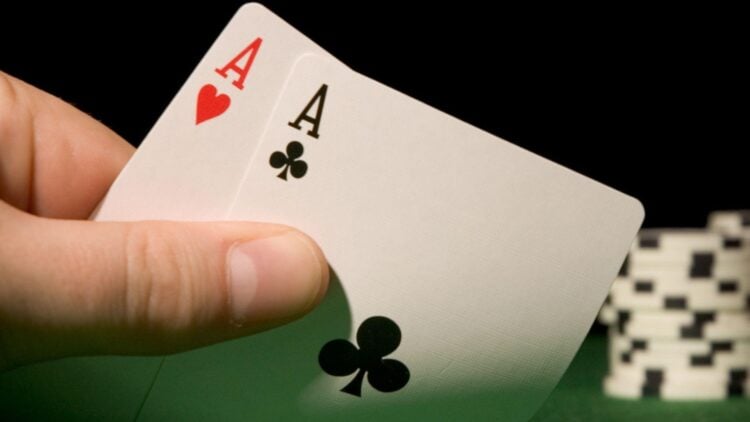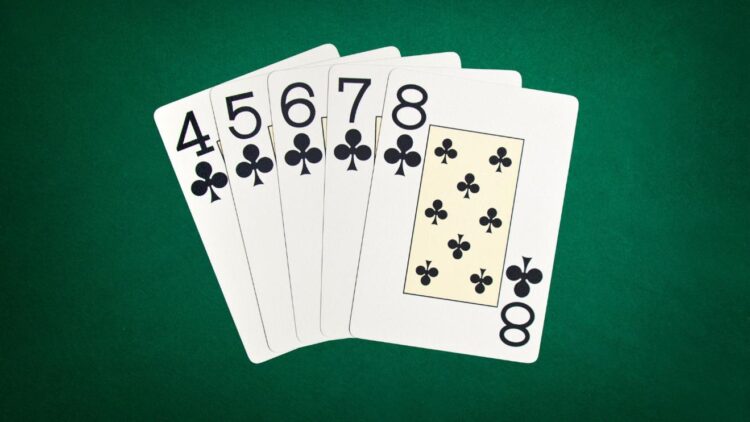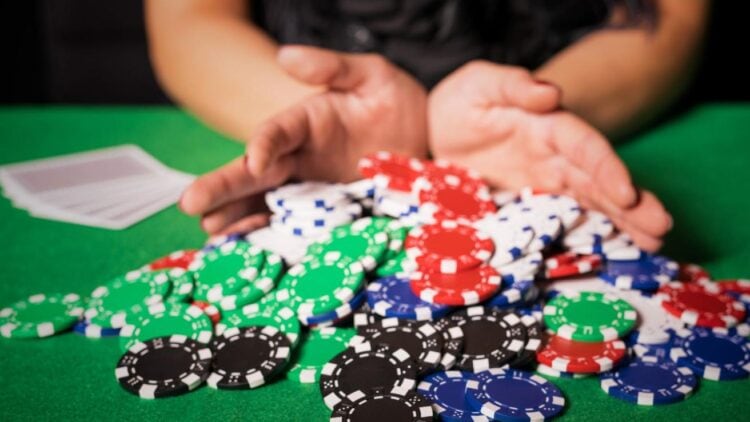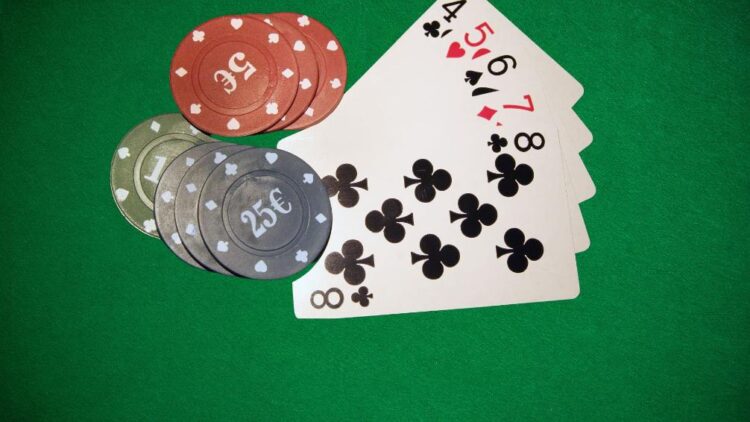
OBJECTIVE OF POKER: Win all the money in the pot, which consists of bets made by players during the hand.
NUMBER OF PLAYERS: 2 to 8 players
MATERIALS OF POKER: Standard 52-card deck
TYPE OF GAME: Casino
AUDIENCE: Adults
OVERVIEW OF POKER

Poker is foundationally a game of a chance. The addition of betting to the game added new dimensions of skill and psychology which allows players to strategize within a game that is largely based on random chance (but, of course, some skill is involved, too!). The name poker is thought to be an English derivative from the Irish “Poca” (pocket) or French “Poque,” although these games may not be the original ancestors of poker.
There are many, many types of poker games played around the world, with different variations popping up all the time. If you’ve never played poker before, you’re in the right place! In this article, we will cover all of the basic rules of poker so that you can play a variety of different poker games. Ready to have some fun?
THE DECK
Poker games use standard 52-card decks. However, players may choose to play poker game variants that include Jokers (as wild cards). You generally play poker with just one deck of cards, but casinos and clubs will usually alternate between two decks for faster play.
The cards are ranked in poker from high to low: A, K, Q, J, 10, 9, 8, 7, 6, 5, 4, 3, 2. But keep in mind that some poker game rules state that aces are the lowest card, not the high card.
In a deck of cards, there are four suits: spades, diamonds, hearts, and clubs. In a standard poker game, the suits are not ranked. Instead, “hands” are ranked. Your hand is the five cards you hold at the time of the showdown, which happens after all the betting is finished and players show their cards to determine who wins the pot. Typically, the person with the highest ranking hand wins. But, conversely, in lowball poker games, the lowest hand wins. In the event of a tie, the pot is split.
POKER CHIPS
You generally play a poker game with poker chips. Here are the usual values for the poker chips:
- White – Worth the minimum ante or bet
- Red – Worth 5 white chips
- Blue – Worth 10, 20, or 25 white chips or 2, 4, or 5 red chips
At the very beginning of the poker game, all players must “buy in” by purchasing chips All players must buy in the same amount of chips.
POKER HAND RANKINGS

In a general poker game, your objective is to make the best poker hand out of five cards. To do this, you use standard poker hand rankings, which are as follows:
- Royal Flush: A, K, Q, J, and 10, all of the same suit.
- Straight Flush: Any straight of the same suit. For example, J, 10, 9, 8, 7.
- Four of a Kind: Any four cards of the same value, plus another random card. For example, 8, 8, 8, 8, J.
- Full House: Three cards of one value and two cards of another value. For example, J, J, J, 2, 2.
- Flush: All cards of the same suit. The value doesn’t matter.
- Straight: 5 cards of consecutive value but of different suits.
- Three of a Kind: Any three cards of the same value, and two random cards. For example, 5, 5, 5, 3, J
- Two Pair: Two pairs of cards of equal value and one random card. For example, 8, 8, 4, 4, J.
- Pair: One pair of cards of equal value, and three random cards. For example, Q, Q, 8, 5, 3.
- High Card: No cards interact with other cards in any way, so the highest value card.
In some cases, there can be two hands in a poker game that are completely identical since suits do not have any rank in poker. If this happens, the players who are tied divide the pot. However, if the two winning hands have the same pair or the same two pair, the value of the remaining card or the highest value amongst the remaining cards wins.
For example, if Player 1 has 10, 10, 9, 4, 2, and Player 2 has 10, 10, 8, 7, 6, Player 1 wins. Similarly, if Player 1 has K, K, Q, Q, 10, they beat Player 2 who has K, K, Q, Q, 3.
If you’d like a more in-depth look at the rankings for all sorts of poker games, check out our full Poker Hand Rankings guide.
DEALING IN POKER
Before you officially start a poker game, you need to shuffle and deal the cards. Choose a player to deal the cards and pass this responsibility onto the next player for the following game, and so on.
To shuffle and deal in poker the proper way, check out our guide, otherwise follow these steps and rules:
- Make sure there are 52 cards.
- Wash the cards by spreading the cards across the table and then mixing them.
- Square up the deck.
- Split the deck into two and riffle the cards by putting one card on top of the other before bringing them together.
- Cut the deck by taking at least four cards from the top of the deck.
- Repeat steps 4 and 5 several times until the deck is fully shuffled.
- Make sure no one ever sees the bottom card.
- If there are any complaints about the shuffle or cut, complain before the game officially begins!
- Starting to the dealer’s left, deal the cards clockwise around the table, one at a time.
BETTING IN POKER

A poker game does not go without betting. During the course of a poker game, there will be one or two betting rounds during which players can bet on their hands. There are also several variations in poker betting, so hold on to your chips and read on to learn more about how to bet in a poker game.
BLINDS AND ANTES
Blinds form the base of a poker game for many poker variants, including Texas Hold’em. So, how exactly do the small blind and big blind work?
In games with blinds, the player to the immediate left of the dealer must pay the small blind. And the player to the left of the player who paid the small blind must pay the big blind, which is generally two times the amount of the small blind.
For a cash game, it’s easy to figure out how much the blinds are by checking the listing of the game. For example, a $10/$20 cash game means the small blind is $10 and the big blind is $20.
In most poker games, the minimum bet allowed at any betting round is equal to the amount of the big blind. So, in the above case, the minimum bet during the game would be $20.
Now, in Texas Hold’em and Omaha poker, the player to the left of the big blind player starts the preflop betting round by either calling the amount of the big blind, raising, or folding. We’ll get into this more in-depth below!
On the other hand, antes are mandatory for all players sitting at the table. For example, a $10/$20 cash game with a $5 ante requires every player to also put $5 each in the pot before the hand begins.
CALL, RAISE, AND FOLD
After the blinds and antes (if applicable), it’s time to bet! Any bets are also put in the pot in the middle of the table. During gameplay in poker, when it is your turn to bet, you have three options:
- Call: You may call by betting the amount wagered by a previous player. For example, if you bet $5 and another player raises the bet amount to $10 (raises another $5), you may call on your turn by paying the pot the additional $5, thus matching the $10 bet amount.
- Raise: You may raise by first betting the amount equal to the current wager and then betting more. This increases the wager or bet amount on the hand, which other players must match if they wish to remain in the game.
- Fold: You may fold by laying down your cards and not betting. You do not have to put money in the pot but you do sit out on that hand. You forfeit any money wagered and have no opportunity to win the pot.
Betting rounds continue until all players have called, folded, or raised. If a player raises, once the raise has been called by all remaining players, and there is no other raise, the betting round ends.
BETTING LIMITS
Before you begin a hand, you should always determine a betting limit. Throughout the game, you can change the stakes by altering the limit if all players agree.
Here are three popular limit systems:
NO LIMIT
A no limit poker game means exactly what you think it means. In a no limit poker game, players can bet all their chips at any point.
For example, in a no limit game where all players have $100 in chips, a player may bet any amount, including all their chips. If a player bets all $100, this is also called going all-in. Note that the maximum amount a player can bet is however many chips they start the hand with. In other words, if you start with $100 worth of chips at the start of your hand, you can’t add another $100 in the middle of the game when you know you have a strong hand.
POKER RULES FOR “ALL IN”
There are a few rules to keep in mind when you go all in on a poker hand. If a player is all in, you can never call more than what you have on the table. You can’t win more than what you have on the table, either. Let’s explain this in further detail.
For example, let’s say there’s currently $1,000 in the pot. If the previous player goes all in for $100, but you only have $50, you can still call. However, if you call and win, you win the $1,000 in the pot plus your $50 back, as well as the $50 you were able to match, for a total of $1,100. The player that went all in for $100 gets $50 back as well, as this is the amount you were not able to match.
SIDE POT
To make things a bit more complicated, what happens when one player is all in and has no more chips, while two or more players are still battling it out? In this case, there will be a side pot.
For example, if Player 1 goes all in for $100, but the other two players have $200 each, they can each call the $100. Then, while the main pot is now $300, the other two players who still have chips can continue to put more chips in a side pot. However, this side pot can only be won by these two players, not Player 1.
FIXED LIMIT
In a fixed limit poker game, rules state that no one can bet or raise more than a predetermined number of chips. This limit may vary throughout the game. For example, in draw poker, the limit may be 5 before the draw but then 10 after the draw. Or in stud poker, the limit may be 5 but then 10 for the final betting round.
POT LIMIT
Finally, in a pot limit poker game, rules state that any bet or raise is limited to the number of chips in the pot at any given time. In other words, a player may bet anywhere between the minimum bet amount and however much money is in the pot. Okay, let’s break this down a little bit to make it clearer.
For example, in a $5-$10 hold’em poker game, if there is a total of $40 in the pot after the flop, the first player to act on a betting round can bet anywhere between $10 and $40. And if this player decides to bet $20, the next players can now call, raise, or fold. When raising, the next player can raise a maximum of $60 (which is the current amount in the pot, as the first player bet $20), for a total bet of $80 (including the $20 current bet).
DRAW VS STUD POKER RULES
There are two main types of poker games, with slightly differing rules: draw poker and stud poker.
In stud poker, there is a round of betting after each card is dealt. The first card dealt is face-down, this is the hole card. There may be an ante or blind bet players must pay first, and then normal betting ensues. Players bet strategically as their hand grows based on the strength of their cards and their opponent’s cards. The player who bets the most wins if everyone else folds. At the showdown, however, the player left with the highest hand wins the pot.
In draw poker, five cards are all dealt at once, two of which are dealt face-down. These are hole cards. After the deal, a round of betting ensues. Betting continues until all players are “square” with the pot, meaning if a player raises during betting, you must at least call (pay the pot the new bet amount) or choose to raise the bet amount (forcing other players to put more money in the pot). If you do not want to match the new bet, you may choose to fold and throw in your hand. After the first round of betting, players may discard up to three unwanted cards for new cards. This ushers in a new round of betting. After the pot is square, players reveal their cards in the showdown and the player with the highest hand wins the pot.
END OF GAME
There are two ways a poker game ends:
- All other players but one fold their cards. The remaining player is the winner.
- One player wins at the showdown.
The showdown occurs at the very end when there are at least two players still remaining after all betting rounds. This is when all players remaining show their hands. The player with the highest hand wins.
DIFFERENT POKER GAMES

Now that you’ve got the basics down, you’ll easily be able to pick up different poker game rules. There are many types of poker games played around the world, with each of them following the basic structure outlined above. Here are the different poker games you can play and their rules:
- Texas Hold’em: Players make up the highest possible poker hand of five cards, using the two initially dealt cards and the five community cards.
- Omaha: Similar to Texas Hold’em, but players must use two of their four private cards in combination with three of the five community cards to make the highest possible poker hand.
- Pineapple: Similar to Texas Hold’em, but players receive three hole cards instead of two and must discard one after the flop.
- Lowball: This is a poker variation where the lowest hand wins.
- 2-7 Triple Draw: A lowball variant, players are dealt five private cards, with three opportunities to exchange some or all of them in order to achieve the lowest possible hand.
- 5-Card Draw: Exchange some or all of your five hole cards in an attempt to make the best hand.
- 7-Card Stud: Players receive seven cards, with three face-down and four face-up, aiming to create the best five-card hand.
- Chinese: Players receive 13 cards and must arrange them into three poker hands – two five-card hands and one three-card hand.
- Horse: A mixed game that includes poker variations such as Hold’em, Omaha, Razz, Seven Card Stud, and Eight or Better.
- Poker Dice: A dice game where players roll five dice and try to achieve the best poker hand.
POKER STRATEGY
Once you get the hang of the basic poker rules, it’s time to implement some poker strategy so you can come out on top! Here are some of the top poker strategies to keep in mind to help you win some bucks!
BLUFFING
If you’re at all familiar with poker, you’ll already know the strategy of bluffing. The trick is to become good at it. So, when exactly do you bluff?
You bluff when you have a weak hand, but you don’t want to show it in order to get other players to fold, even if they potentially have a stronger hand.
You can also semi-bluff, which is a strategy that helps players improve their hands by forcing players with weaker hands to fold in order to improve the odds of winning the pot!
SLOW-PLAYING
Basically, the opposite of bluffing, another strategy you can use is slow-playing. You can use this strategy if you have a strong hand. But instead of acting confident, you check or place small bets in order to slowly increase the pot by getting players with weaker hands to raise.
PAY ATTENTION TO YOUR OPPONENTS
Of course, the most important strategy in any poker game is to pay attention to your opponents. As you pay attention, you may pick up on your opponents’ “tells” that demonstrate that they are bluffing. Examples of tells include:
- Looking nervous
- Looking at something else in the room
- Tapping the table
- Twitching
Players generally display tells when placing a bet, so pay attention! As you play more and more games, you’ll be able to get to know your opponents, thereby increasing your likelihood of winning the pot.
FAQ
Is Poker Skill or Luck?
It’s a bit of both, but, interestingly enough, poker is primarily a skill game. Of course, luck plays a huge role in this card game, as it is the predominant factor that determines a winner or loser. But since poker players play more than one hand, in the long-term, skill plays a big factor.
Is Poker Gambling?
Poker is largely considered a gambling game, but it’s a specific type of gambling game that still requires some skill to play. Furthermore, players often bet money to play.
What Is a Straddle in Poker?
A straddle in poker is a blind bet you can make before the dealer deals the cards. If you straddle, you double the stakes, with a standard straddle bet usually equal to two times the amount of the big blind.
Can You Play Poker Without Chips?
Yes, definitely! You can play poker with any countable object as a substitute for chips. For example, you can use Monopoly money. Or, if you want to amp the stakes up a little bit, you can play Strip Poker by betting clothes instead!
- 200+ INSANE “KISS MARRY KILL” QUESTIONS TO ASK - April 16, 2024
- 15 BOARD GAMES FOR 5 YEAR OLDS (THAT EVEN YOU WILL ENJOY) - November 10, 2023
- 21 BACHELORETTE PARTY GAMES THAT EVERYONE IS GUARANTEED TO LOVE - December 13, 2022